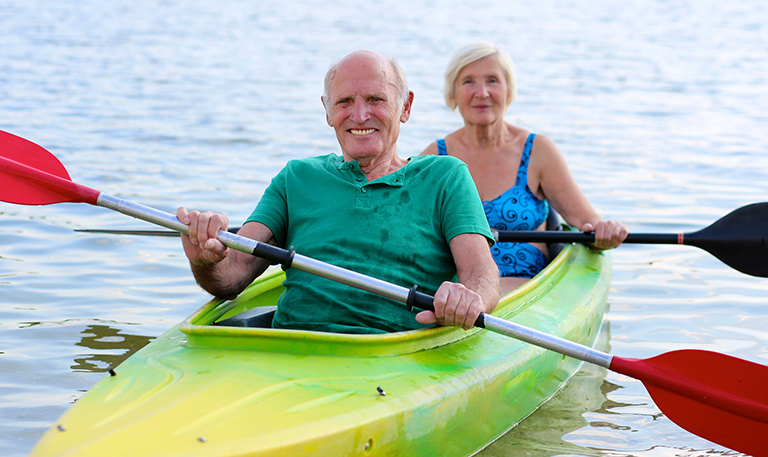Washington’s ample coastlines and lakes make water activity an attractive pastime for locals and out-of-towners alike. Rowing, kayaking, and paddle boarding continue to grow in popularity and accessibility. Taking steps to train before you hit the water will help you enjoy your activities without injury or fatigue.
Rowers find that proper form makes the difference between back pain and a day of fun. A rowing machine at the gym will allow you to practice your form and tempo before you get out on the water. Keeping your back straight while sitting on the rowing machine, begin by leaning toward the front of the machine. Tuck your knees toward your chest, push your legs down toward the machine, and pull back. Take your time to establish technique. I highly recommend asking a fitness professional to assess your rowing form. That way, you can avoid developing bad habits. Continued rowing workouts will improve your form and cardiovascular endurance so you can keep up on longer rows, whether by yourself or with the team.
Kayaking has exploded in the Northwest, and with good reason: Kayaks’ portability and ease of use make them an excellent option for beginners and experts alike. Shoulder pain is the bane of many new kayakers, but proper paddle handling will prevent injury and muscle fatigue. Hold the paddle in front of your body in line with your shoulders. Your elbows should both be bent at a 90-degree angle, which will prevent shoulder inflammation. Alternate pulling the paddle to either side of your body while maintaining a straight back, and don’t allow your elbow to pass your torso. I recommend that all kayakers take a water safety course, especially if you plan to kayak in the open waters of Puget Sound.
Paddle boarding has been migrating from Hawaii to the Great Northwest. Many people have embraced paddle boarding as a scenic way to practice yoga on the water. Traditionally preformed standing, paddle boarding requires strong core muscles and balance. To prepare for your first paddle boarding session, practice standing on a BOSU (a brand of balance trainer) or similar balancing board. This helps your body adapt to instability. Use a long dowel or PVC pipe to mimic the paddle movement on either side of your body. To replicate the resistance of a paddle in the water, I suggest using a Rip Trainer, a product from TRX used to develop rotation strength. A metal stick attached to a heavy duty stretch cord, it can be attached to a base support for portable strength and endurance training. Use the same technique that you practiced with the dowel to practice for paddle boarding. This unique device can be used to train for both rowing and kayaking alike.
Summertime boating activities can be an excellent workout, especially if you prepare by planning ahead in the gym. In addition, I recommend a water safety course to help you handle any problems that you may have on the water. Ask about classes at your local swimming pool, and get ready for a great summer.
Kyle Ciminski is a personal trainer at Fidalgo Pool & Fitness Center in Anacortes. He holds more than 30 training certifications, and his specialties include injury recovery and training active seniors.


